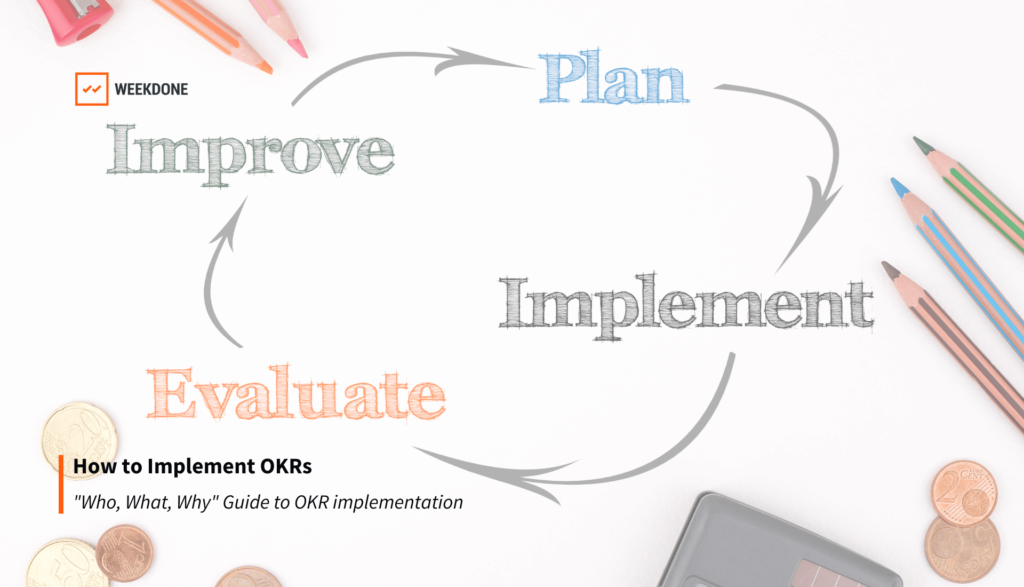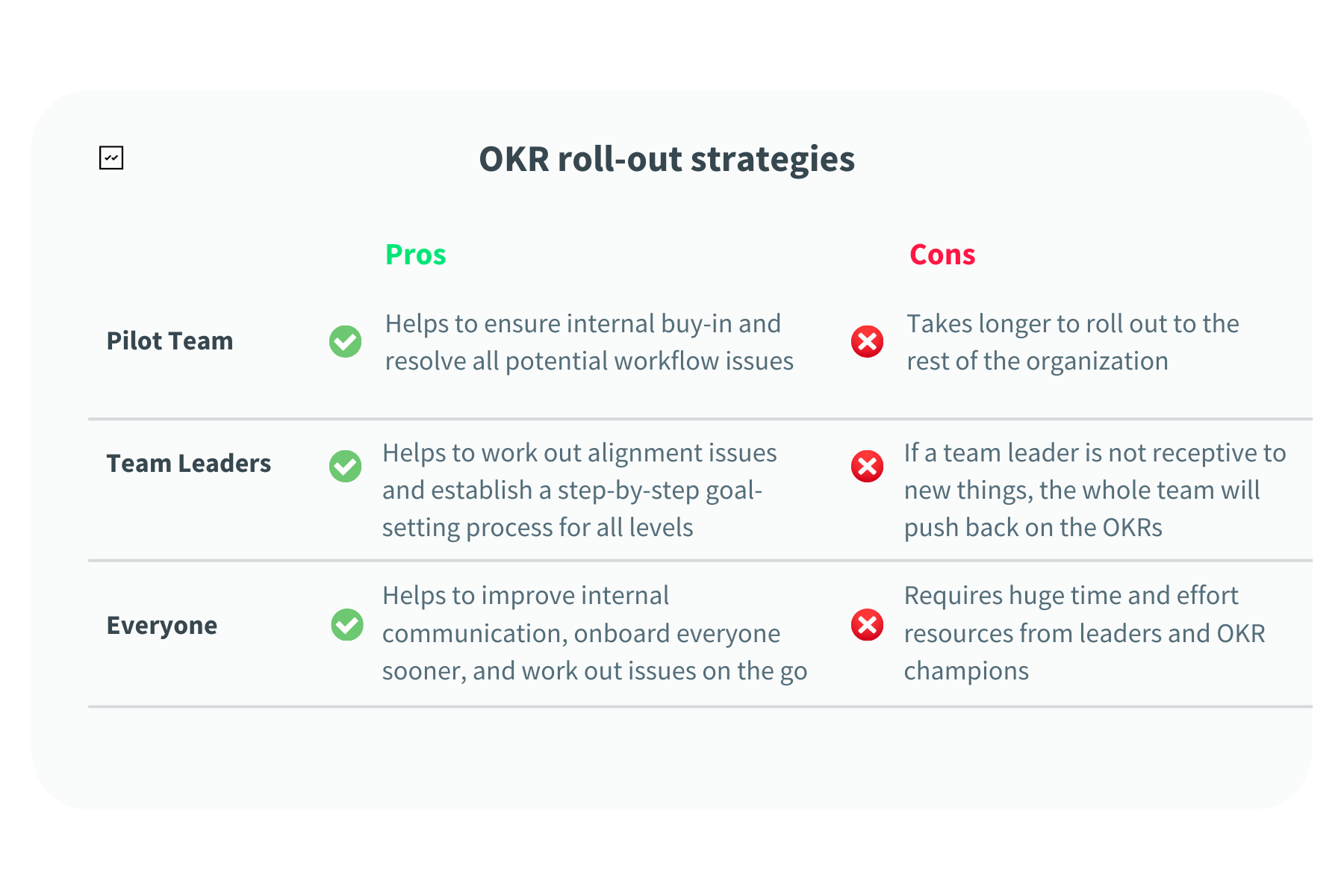
Once you’ve learned the basics of the OKR methodology, and have decided to use it – you’ll need to consider how to implement it. One of the most important elements of proper OKR implementation is the time and preparation put into the discussions.
First, you need to decide who will be using OKRs. Is it only one team, or will you introduce it to the whole organization?
In this article, we’ll discuss 3 strategies for implementing OKRs for the first time – including a timeline to follow, plus tips for managing your Objectives and Key Results over time.
Already familiar with the methodology? Try Weekdone OKR tool for better OKR tracking and reporting week after week.
Need more than a 2-week free trial? Try our free OKR templates
3 Strategies for Implementing OKRs

1. Pilot Team
By only focusing on one team, you can work out any workflow issues before introducing the new goal-setting framework to everyone.
The Pilot Team strategy could be based on how open-minded a group of people are. If you have a functional team (like business development, growth, etc.) with a growth mindset and readiness to try new things, that group of people should be your first choice.
However, very often you have specific individuals ready to try new things but not one complete functional team. In this case, you can consider assembling a cross-functional group of OKR champions – a guiding coalition – who will learn the methodology, and teach it to their own respective teams when the time is right.
A guiding coalition can consist of managers and specialists alike, and their sole purpose would be to learn and practice the OKR processes. This group works to create the best way to bring everyone else onboard.
Although OKR implementation through a Pilot Team is arguably the most effective approach – it will take longer to introduce the methodology to the rest of the company. But the return could be necessary if you’re serious about OKRs and want to see lasting, company-wide changes.
This should be a go-to approach for companies with 50+ employees.
Need help implementing OKRs into your SMB? Contact Weekdone OKR experts to see how our trainings can help you succeed.
See training opportunities with our Weekdone OKR expert
2. Team Leaders
By starting OKRs with team leaders only, you can work out the challenges of goal alignment and see how team level OKRs connect to overarching company goals. You’ll get a preview of what the OKR hierarchy will look like – allowing you to determine how OKRs will work for the whole company.
The benefit of this approach is that it sparks the mindset shift – defining the success of goals by outcomes vs outputs. This is a huge change for organizations, and if team leads are properly onboarded, then everyone else will see how the framework works, and that it should be taken seriously.
Be mindful that some people are naturally and intuitively drawn to the OKR mindset, while others may need some time to adjust to a new goal management method.
This approach works well for many companies regardless of their size. As long as the team leaders involved are equally motivated to make OKRs a success in the company.
3. Company-Wide
Implementing OKRs to everyone at once can be tough. Therefore, we recommend this option to:
- SMEs (small to medium size enterprises) or;
- Companies with flat hierarchies
The benefit of onboarding everyone together one day 1 could mean seeing results sooner since you can expect to see the real magic of OKRs after 2-3 quarters.
If you are onboarding everyone at the same time, be ready to keep your lines of communication open to your employees. People often have many questions and require guidance along the way. Offering support during the implementation phase is crucial.
It is absolutely necessary to have full leadership buy-in, meaning the C-level leaders agree, support, and are ready to “dive all in” to the framework. Additionally, you’ll need a few people to be OKR champions.
Both leaders and OKR champions should be go-to coordinators of the undertaking.
Companies with 20+ employees would definitely need an OKR coach (internal or external) to guide them through the process and make sure everyone follows through.
📚 Weekdone Case Study – How Foodbomb COO took on the role of OKR Champion to implement the methodology across the organization.
OKR Implementation Timeline
Whichever strategy you choose, there is a process toward success with OKR implementation, and beyond.
In this section we cover: what to do before you implement OKRs, how to manage them during the execution quarter, and the final 2 weeks of review.
Learning OKR best practices is a continuous effort that goes beyond your first quarter. Weekdone offers educational materials in our Learning Center to all registered OKR software users.
Sign up for Weekdone OKR software
1-2 Weeks Before the Quarter
Setting Company Objectives
First, start by defining your quarterly company level Objectives. You may also decider to have one longer term annual Objective to guide the quarterly Company O’s. However, this is optional.
Should you decide to set an annual Objective, keep it on the company level only. Don’t connect it to your lower levels (department, team, individual) – this keeps your goals agile.
When starting out with OKRs, it’s important to remember that you should only create a few company level overarching Objectives.
We suggest setting between 1 and 3 quarterly Company Objectives. These should be discussed with managers, team leads, and whoever else is involved in the switch to OKRs so everyone agrees on the most important goals for the company.
| Aligning Annual and Quarterly Objectives Example: Annual Company Objective: Increase company growth Quarter 1 Company Objectives (bringing more focus to annual Objective) Company Objective 1: Understand and analyze our customers better Company Objective 2: Create a better workplace for our employees These quarterly Objectives help you realize your annual Objectives by looking for the positive outcomes to better aid customers or staff. Teams create their Objectives and measurable Key Results with the quarterly Company Objectives at focus. |
This process of getting feedback on the Company level Objectives will help you validate them from the execution perspective. If a goal is not achievable, or unreasonable for this quarter, feedback from employees will indicate that.
Writing Team OKRs
You can then repeat this process at the team level. At the team level, team leads should consult their team members to decide on team-important goals while team leads should make sure that these goals align with the Company Objectives.
Writing Team Objectives is a critical thinking exercise, and it will involve a lot of discussion so make sure to allocate enough time for them.
Each Team Objective should have 3-5 Key Results to measure success or failure of this Objective. In the process of drafting an OKR, writing Key Results takes up most of the time.
| Tip: Write Key Results, Not Tasks |
|---|
| Let’s say, you are organizing an event. There are a series of tasks to be done, for example: 1. Rent a venue, 2. Book a band, 3. Organize someone to host, 4. Hire catering, etc. Your Key Results should measure the impact of the entire event. For example, your Key Results can be: 1. Increase ticket sales from 1,500 (last event) to 2,500 2. Get a 4.5/5 rating from TripAdvisor 3. Achieve renown at 5 different news channels 4. Have 50% of attendants sign up for the company newsletter and updates about the next event. |
Feedback & Finalization
The final step before finalizing OKRs is the last round of feedback where Objectives and Key Results can be added, deleted, or changed.
Presenting a Team OKR for the rest of the Company should take place before the quarter starts so that there is enough time to work out cross-functional dependencies with other teams and agree on the rational use of resources.
During The Quarter
Weekly Check-Ins
It is incredibly important that an OKR check-in process is implemented and followed.
This means teams should have Weekly Check-ins to see how their goals (Objectives) are progressing. Do not wait until the end of the quarter to do this, as OKRs require a continuous evaluation process. Likewise, if no one is checking in on their OKRs, they will probably forget about them, destroying all the hard work they put into setting them in the first place.
Once a month
Make sure to have OKR review team meetings every month to summarize lessons learned and adjust the tactical approaches to the Objective.
The purpose of these meetings is to identify problems and brainstorm ways to fix them . Team managers should present these lessons learned during a company-wide monthly OKR review. A cross-functional company-wide OKR review is a great way to stay aligned and ensure better collaboration among teams.
Final 1-2 Weeks of the Quarter
At this point, the entire company should review the Company Objectives to see the progress that has been made towards them at every level. It’s definitely a good idea to gather some input on this quarter’s OKRs and ideas for the following quarter.
The purpose of the company-wide quarterly OKR review is to look at everyone’s progress from a big picture angle and collect important learnings to set better OKRs for the next quarter.
| Good Questions to Ask as a Team |
|---|
| – How did your team perform? – How big was the contribution of the Team Objectives to the overarching company goal? – Were the OKRs set a good choice for the team? Did they help the team make improvements for the team as well as the company? – If the OKRs failed, then why? – What were the challenges this quarter? – Lessons learned – what can be done better next time? – What are some ideas for the upcoming quarter? – Were the Key Results outcomes that moved the Objective forward? – Could we have better Key Results next quarter? |
| Good Questions for Company Review |
|---|
| – How did we (as an organization) progress toward achievement of our high-level Company Objective? – Were the results satisfactory? – Which teams saw the highest impact on their Objectives and Key Results? – How do you support teams that missed the mark? – Did teams feel motivated working with their OKRs? – Was the focus clear to everybody? – What are the main learnings from this quarter? – What can the company improve in their OKR setting and process? |
Further Reading 👉 Retrospectives Best Practices, Tips from an OKR Expert
Managing your OKR Roll-Out
Although every company is unique, most teams go through the exact same challenges when implementing the OKR methodology.
Introducing a new goal-setting approach is not a mechanical, it requires many intentional adjustments. In the end, it is well worth the effort. You’ll notice over time that as individuals are brought up to speed and familiar, there will be a significant (positive) shift across the entire organization – both in culture and productivity.
Your best option for implementing OKRs is to use a dedicated software built on these best practices. Weekdone offers full support of the OKR process. The OKR product features are complimented by Weekly Planning, Initiatives, and KPIs – to promote employee engagement and increase focus week after week.
You can try Weekdone today to roll out your strategy of choice. 2 weeks, full features, unlimited users, no credit card required.